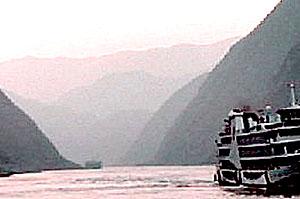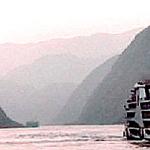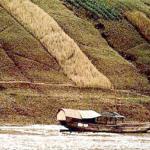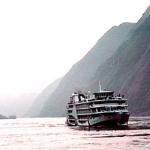Romance of the Three Gorges
As a dedicated follower of Chinese History, I had a childhood dream of seeing the two great rivers of China -- Yangtze (Changjiang) and Hwanghe (the Yellow River). Part of it was realized when I spent five days in the embrace of the majestic Yangtze River, the longest river in Asia and the third longest in the world. The Yangtze stretches 6300 km from its source at the Tibetan Plateau in the West to its estuary in the East China Sea at Shanghai, dividing the country into North and South. The best known stretch is undoubtedly the Three Gorges, which extends from White King Town in Fengjie County, Sichuan Province, to Nanjinguan Pass in Yichang, Hubei Province. Apart from being home to the scenic Three Gorges, the Yangtze River is renowned for its having possessed a good number of historical sites and enchanting scenic spots along its banks.
After delaying this trip for more than three years, I finally embarked on a Yangtze River Cruise to catch a last glimpse of this famous region before the largest (and most ambitious dam), the Three Gorges Dam, is completed. The construction of the controversial hydro-electric dam will cause a steep rise in the water level which will flood much of the region come 2004.
Our journey along Yangtze commenced in the town of Changqing. Here, we boarded the ferry for a five-day Yangtze River Cruise. There was a special room for us first class passengers, with a deck out front, with a perfect view to the changing landscape as we sailed from the industrialized city of Changqing (where using vehicle horns is banned because of the noise pollution it creates) through a more primitive part of China. We brought chairs from the room and sat out there, reading or looking at the landscape gliding by.
Early the next morning, we turned the bend and arrived at the first gorge, the Qutang Gorge. As we watched, an orange sun rose from behind a peak and created the most beautiful mountain sunrise. I had not seen anything like it before.
Touted the most dramatic of the three, Qutang boasts not only splendid views but also places of historical interest. Masterworks of calligraphy and the stone engravings of different dynasties originate from here. The region is the cradle of Chinese civilization. The Daxi culture originated here and it was here that the patriotic poet Qu Yuan lived and died. It was like traveling back in time to the Age of the Three Kingdoms to see the relics of that time, the ancient plank roads on which battles were fought, and White King Town, the most ancient town in the Three Gorges, built by Zhuge Ling during the same era.
After another hour's or so ride from Qutang, we arrived at the Wu Gorge. Named after Mount Wushan, it is characterized by towering peaks and steep cliffs with countless twists and turns in the ever-changing course of the winding river.
The second gorge is best known for its 12 peaks that create some of the most spectacular scenery. Like a kaleidoscope varying in shape, color and pattern, the peaks have been given names like Soaring Dragon, Fairy-Gathering, Flying Phoenix, Rising Clouds and Green Spring by Chinese Scholars. The most fascinating is perhaps the Goddess Peak. Legend says that after Yu the Great, a legendary river-taming hero, split the Wushan Mountains to release a huge body of flood water, a Goddess named Yao Ji flew to the scene. She helped the local people by killing marauding tigers in the mountains and sending heavenly birds to guide boatmen through the rapids and past dangerous reefs. The people built a temple to her, to show their respect and gratitude, and in return she became a mountain peak to keep eternal watch over them.
Near Wu Gorge is the Daning River where the Lesser Three Gorges lie. We took a four-hour boat ride from the Longmen (Dragon-gate) Gorge and sailed upstream where precipitous cliffs face each other closely across the river and tower into the clouds. The next gorge, Bawu, has rare and peculiar rocks and clear green waters with many curious formations resembling objects, animals and human figures. Lastly came Dicui Gorge, the longest of the Lesser Three Gorges.
We caught a glimpse of coffins placed high up in precipitous crevices, an old form of burial. Since this area will also be flooded when the dam opens, our guides say the coffins will be placed in a museum nearby.
That night, our ship reached Gezhouba, a smaller dam which marks the entrance to the Three Gorges. We woke up at five the next morning as our ship entered the last gorge, Xiling. Towering mountains in various shapes loomed around us. It was extremely chilly but the sheer excitement of the magnificent sight almost made us forget the cold. Xiling Gorge has been described by an ancient poet as "torrents from above falling upon ten thousand snow drifts". There is gorge upon gorge and shoal upon shoal, where smaller gorges and shoals were hidden in bigger ones. Some of the shapes had names like Books and Sword, Bull's Liver, Horse's Lung, Shadow Play and the Ox Gorge.
Populated by the Han and Tujia people of Sichuan and Hubei provinces who inherited unique customs and folklore, the commemoration of the Eight-Element Battle Formation is like an exquisite painting depicting their folkways. The dragon boat race in Zigui, the baskets carried on the people's backs in Badong and the strange wedding and funeral ceremonies of Tujia add color to the mystique of the Three Gorges.
The little towns and cities dotted along Yangtze too have interesting stories of its own. Located on the north bank of the Yangtze River, Fengdu is an ancient city with long history. It is also known as the so-called "Abode of Ghosts." According to a legend, "the dead come to Fengdu and the devils go to hell." Since the Tang Dynasty, forty-eight temples have been built in this place, such as the "Hall of the Jade Emperor," the "Palace of Hell, " "Boundary Between the Living and the Dead, " the "ridge of Helplessness," and the "Balcony of Nostalgia." All of the temples there look quite magnificent while statues are extremely lifelike.
On the south bank of the Yangtze River in Yunyang County, 64000 meters away from Wanzhou, is the historical Zhang Fei Temple. Built in memory of Zhang Fei, the famous general during the Three Kingdoms Period, is one of the well-known scenic spots in Sichuan Province. As an architectural complex, it has now become one of the famous cultural and historical relics on the Yangtze River. There are famous poems, calligraphy, stone and wood carvings and paintings in the temple. So the place is noted for its having housed some gems of the artistic works.
Despite such rich heritage along the river banks, huge white boards placed on the mountain-sides telling how high the water would stand when the controversial Three Gorges Dam would be finished is an indication of how history will be buried once the dam is ready. Here were often two signs, one showing what level the water would rise to when step 2 of the building process would be finished in 2004, and one showing were the water would stand when the dam was finished in 2009. It was incredible seeing the houses, villages and cities which will be lying under water (or rather be blown up, so that boats can go to shore without crashing in a roof) when the dam is finished.
As we reached journey's end, I could not help but feel heavy-hearted that so many of China's historical and nature wonders - the animal-shaped stones of the Daning River, the Zhang Fei Temple and the historical remains of the Three Kingdoms - are so soon to be swallowed up and lost in the rising tide of change.
* * * * *
 ThingsAsian
ThingsAsian




















